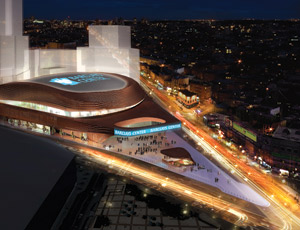Design firms throughout the region continue to suffer the pains of the recession, but some see signs of relief on the horizon. As with 2009, designers saw a dribble of work flow from private-sector clients last year as financing remains elusive. But ongoing public-sector and institutional clients continue to buoy the market for many firms. Public money is drying up fast, but some executives at local design firms are hopeful that a surge in private work could keep revenue flowing.

On paper, 2010 appears to have been a steady year for top firms. The top 50 firms on ENRNew York's Top Design Firms list, which ranks firms by revenue in New York, New Jersey and Connecticut, report a combined $3.5 billion in revenue for 2010, up slightly from $3.4 billion in 2009. However, much of that improvement can be attributed to a jump in revenue by AECOM, New York, which now includes some design-related fees through Tishman Construction in its tally. AECOM acquired the firm in July, which helped its tally nearly double to $803 million in 2010 from $402 million in 2009. Removing AECOM from the equation reveals a slight revenue drop last year for top firms.
Public dollars remained the primary lifeline in 2010. The New York office of Perkins+Will saw its “strongest years in a decade” during the recession, says Paul Eagle, managing director at the firm. In 2009 the firm garnered $42.6 million in regional revenue and followed up with $45.3 million in 2010.
“One of the reasons that we've been able to hold off the ravages of the economy has been our diversification across different market sectors and disciplines,” he says. “During a recession, it's the public sector work, in particular, that helps soften the impact of dips in the private sector.”
Much of the firm's recent uptick in revenue stems from its work at the $1.9-billion United Nations Headquarters project in Manhattan and the New York Police Academy in Queens, which broke ground last year.
HDR's New York office maintained a hot streak through the downturn. Between 2007 and 2010, the firm nearly doubled its revenue to $119 million from $61.5 million. Pete McGroddy, senior vice president at HDR, credits a combination of lucrative acquisitions and the firm's ability to secure long-term public projects. HDR is part of a construction management team for the No. 7 Subway Line extension in Manhattan, is engaged in ongoing Superfund contracts through the federal government and holds hazardous waste contracts with New York state.
Education projects have also helped firms hold steady. Davis Brody Bond Aedas, New York, experienced a revenue rebound in 2010, bouncing up to $32.7 million last year from $23.5 million in 2009. Seizing opportunities among higher education clients played a significant role in the firm's financial picture, says William Holman, chief operating officer.
“We've maintained relative consistency among university clients,” he adds.
The firm's recent education projects include the $180-million Princeton University Neuroscience & Psychology Complex in Princeton, N.J., and renovation work for CUNY at Baruch College in New York.
Public Slowdown
After roughly two years of propping up the ailing design and construction markets, public coffers are running thin. Government funding kept many firms busy during the downturn, but design firm executives see signs of a slowdown.
Milo Riverso, president of STV, New York, says his firm has held steady in the New York market thanks in part to a mix of big transportation projects, such as the Long Island Rail Road's East Side Access project and smaller projects supported with funds from the American Recovery and Reinvestment Act. Still, the future funding picture is uncertain.
“We've seen it here and all across the country,” he adds. “Funding for capital programs is drying up as the [federal] government, states and municipalities struggle to deal with their operating budgets. When you look at the budget in New York state, there are no major things to go cheerleading about in there.”
Like many firms with private-sector clients, Langan Engineering & Environmental Services, New York, navigated through choppy financial waters for much of the recession, but David Gockel, president and chief executive officer at Langan, says the firm saw the design and construction market stabilize in 2010 and could see a wave of private money roll in this year.
“Things are starting to shape up nicely in 2011,” he says. “We've gone from not enough work to not having enough people. The landscape is changing. People are getting restless. Rentals [apartments] are hot and we've even seen an uptick in retail. We think 2011 will be the year that the private sector reemerges.”


Post a comment to this article
Report Abusive Comment